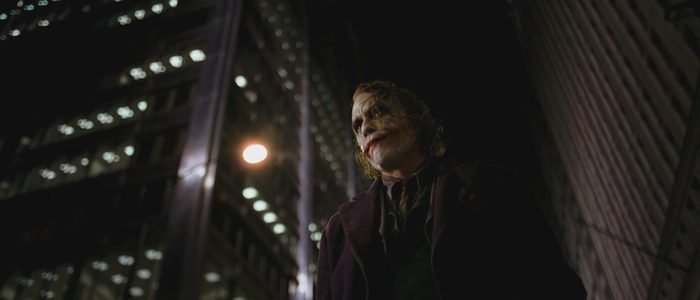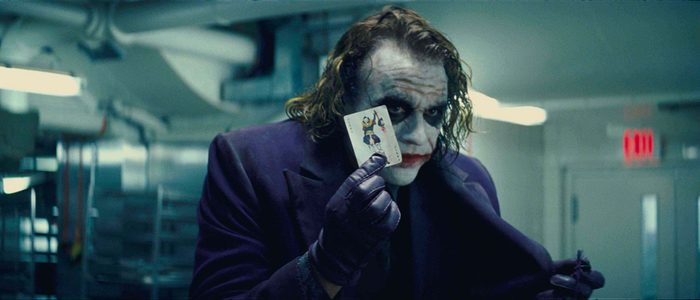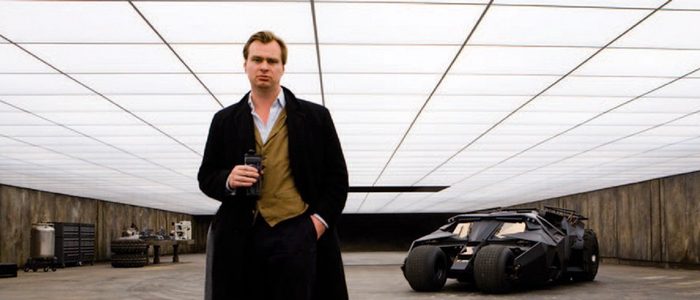(Welcome to The Dark Knight Legacy, a series of articles that explore Christopher Nolan’s superhero masterpiece in celebration of its 10th anniversary.)
This week, The Dark Knight turns 10 years old. Its legacy still looms large, for better and worse. Here is the story of how Christopher Nolan changed the face of superhero movies forever. The story of how one movie proved that comic book adaptations could be a lot more than kids stuff. And the story of how some of it backfired, giving birth to a new era of fandom that just wanted to watch the world burn.
Why So Serious?
Summer, 2008. The hype for Christopher Nolan’s The Dark Knight was at a fever-pitch. The early release of a prologue scene, coupled with fantastic trailers, had caught the attention of seemingly everyone – bat-fan and non-bat-fan alike. The tragic death of co-star Heath Ledger had only increased the anticipation for the film. The actor was generating buzz for his portrayal as the Joker before his passing in January of that year, and after Ledger’s demise, rumors began circulating that he had taken the role of the Joker so seriously that it had ultimately destroyed him. These rumors were rubbish –friends and family (not to mention the crew of The Dark Knight) would go on record numerous times stating that Ledger was having an absolute blast playing the Clown Prince of Crime. But the legend stuck – even after the debunking, some still thought that maybe, just maybe, the Joker was the role that killed Heath Ledger. And that only increased the excitement to see the film.
The early reviews started pouring in. They were immediately, and overwhelmingly, positive. Rolling Stone, Entertainment Weekly and Time all raved. Roger Ebert wrote: “Batman isn’t a comic book anymore. Christopher Nolan’s The Dark Knight is a haunted film that leaps beyond its origins and becomes an engrossing tragedy. It creates characters we come to care about. That’s because of the performances, because of the direction, because of the writing, and because of the superlative technical quality of the entire production. This film…redefine[s] the possibilities of the ‘comic-book movie.’”
Fans were ecstatic.
And then it all started to go wrong. At least, in the eyes of some. While the end-tally of reviews for The Dark Knight would make it one of the best-reviewed comic book movie of all time, there were some outliers. David Fear gave the film a less-than-positive review in Time Out New York. Ditto David Denby in The New Yorker. And the outrage in the fan community turned toxic – so much so that Denby ended up receiving death threats on Rotten Tomatoes.
What was happening here? The Dark Knight didn’t give birth to toxic fandom. There have always been a subset of hardcore fans who take their respective fandoms very, very seriously. Even within the world of Batman, toxic fandom had flourished before Nolan’s 2008 blockbuster. But usually such angry diatribes were directed at the makers of the films, not the critics. Joel Schumacher was practically burned in effigy after he turned Tim Burton’s dark and moody bat-series into a neon-drenched carnival. And even Nolan was not above reproach – when it was announced the filmmaker had cast Ledger as the Joker, several fans practically lost their minds. The general (and, let’s face it, homophobic) consensus at the time of Ledger’s casting seemed to be: “How could Nolan cast the guy from the gay cowboy movie as the Joker?”
But the ire and rage boiling over upon release wasn’t directed at Nolan. It was directed at the few critics who dared to say that The Dark Knight was less-than-perfect. It was the beginning of a strange new trend in superhero fandom – anyone who gave a comic book property a bad review was a “hater.” Never mind the fact that most of the people angrily reacting to said negative reviews hadn’t seen the film in question yet. The simple fact was this: a subset of the fandom not just wanted, but needed, legitimacy to be brought to the genre. After Schumacher’s goofball Batman Forever and Batman and Robin, there was a burning desire among bat-fandom to prove that Batman wasn’t kids stuff. It wasn’t fun and lighthearted – it was dark and serious. And more than that, it was legitimate. It wasn’t a comic book movie. It was a movie, plain and simple. That’s what so many fans were aching for, and any critic who dare say otherwise was, in their warped vision, an enemy of the people.
It was a trend that would only continue, and grow. So much so that when The Dark Knight Rises arrived in 2012, Rotten Tomatoes actually had to close down their comments section for the film to stop the death threats against critics giving the film anything other than a 100% positive review. Not even a mixed-to-positive review would do. You had to say the film was perfect, or else you were a hater.
Ultimately, this is a tragedy. Because The Dark Knight is a truly groundbreaking work. A film of immense technical skill, filled with engrossing storytelling, and featuring remarkable performances. But the toxicity has tarnished its legacy. I can freely admit that I think The Dark Knight is a borderline masterpiece. And yet when I admit this, I also cringe ever-so-slightly. Because I can’t help but think that saying such a thing lumps me in with the type of over-the-top wackos who sent out death-threats to anyone who dared to criticize what Nolan had made.
But I come here to praise The Dark Knight, not to bury it. 10 years later, The Dark Knight remains just as haunting as it was when it hit theaters in 2008. Perhaps moreso. Because in the end, Nolan’s film actually believes in hope. Believes that people will ultimately do the right thing. And I’m not sure that’s true anymore. I’m not sure it was true then, either. But perhaps I was naive enough to think it was. “When the chips are down,” Ledger’s Joker sneers, “these civilized people…they’ll eat each other.” In the end, the good people of Gotham prove that this isn’t the case. Here, 10 years later, I’m starting to think that maybe it is.
Aggressive Expansion
The Batman franchise was in a strange place in the 21st century. After the disaster that was Batman and Robin, director Joel Schumacher wanted a chance at redemption. He pitched Warner Bros. a reboot – an adaptation of Frank Miller and David Mazzucchelli’s comic Batman: Year One. Warners didn’t go for it. At least, not from Schumacher. A few years later, the studio would flirt with the idea of allowing director Darren Aronofsky to bring Year One to the big screen, but it ultimately didn’t work out. Finally, Warner Bros. hired Christopher Nolan to reboot their franchise.
Nolan was an unlikely candidate. He had launched his film career with the little-seen thriller Following. The film that put him on the map was Memento, a twisty, clever indie that unfolds in reverse. After that came a remake of Insomnia. None of these films screamed “the next Batman director!” But Nolan landed the gig nonetheless, and he set about making a bat-film unlike any before it.
Nolan’s 2005 Batman Begins borrowed elements of Year One, but also forged its own path. It was a psychological thriller that just happened to be a superhero film. For the first time in film history, a filmmaker wasn’t telling the story of Batman – he was telling the story of Bruce Wayne. Wayne (Christian Bale) doesn’t don his famous cape and cowl till nearly halfway through the movie. The bulk of the narrative is about how Wayne became Batman, and how he returned to his corrupt city of Gotham with the hopes of cleaning things up. As the film ends, Nolan drops a tantalizing teaser: Jim Gordon (Gary Oldman), not yet a commissioner, tells Batman about a criminal with a “taste for the theatrical.” A criminal who leaves a calling card at the scenes of his crimes – a joker card. “I’ll look into it,” Christian Bale’s Batman growls before turning and flying right into the camera. It’s thrilling as hell, but it wasn’t exactly a deliberate sequel set-up.
“We wanted to suggest possibilities for how the story would continue,” Nolan said, “not because we knew we were going to make a sequel, but because that was the feeling we wanted to audience to leave the theater with. The ending of Batman Begins was specifically aimed at spinning off that element of the mythology in the audience’s mind so that they could imagine what they Joker would be in that world.”
Nolan may not have been planning a sequel at the time, but a sequel would happen – after the director went off and made the dueling magicians film The Prestige. That sequel would be The Dark Knight, and it would open up Nolan’s Bat-world in surprising, thrilling ways.
Right from the start, Nolan’s approach to Batman had been to find ways to make the character grounded. What would happen, Nolan’s Batman Begins asks, if Bruce Wayne was a real person, in the real world? The director, working with writer David S. Goyer, did away with comic book fancies and crafted something set in a somewhat realistic world. Or at least, as realistic as a movie about a man in a bat costume fighting a guy dressed as a scarecrow could be.
For The Dark Knight, Nolan would take his thirst for realism to a whole new level. For all its real-world, gritty trappings, Batman Begins still feels like a comic book movie. The Dark Knight is something different. Working with brother Jonathan Nolan, Nolan ended up crafting a crime thriller loaded with allegories to the so-called “war on terror.” This film just happened to feature Batman, the Joker and Two-Face.
The idea behind The Dark Knight was escalation. If Batman existed in the real world – as Begins suggested – how would the real world then react to Batman? The answer: it would inspire people to both emulate, and seek to destroy Batman. At the start of The Dark Knight, we learn an entire gang of dumpy, gun-toting idiots in Gotham City have begun dressing up just like Batman, trying to fight crime on their own. They think they’re helping, but they’re bound to get themselves killed.
As for Gotham, the city is going through a time of change. Batman is a vigilante, so the Gotham police department is technically supposed to arrest him. But Lieutenant Jim Gordon has a friendship with the so-called Batman, and the cops are (mostly) perfectly fine with some random man taking justice into his own hands. Meanwhile, organized crime is running scared. In Begins, we see that Gotham is a city practically eroding from corruption. In The Dark Knight, Batman’s crusade is beginning to put a serious dent in that corruption.
And that’s not the only dent. There’s also new district attorney Harvey Dent (Aaron Eckhart), a Robert Kennedy-esque white knight. A man determined to do the right thing, and bring down the mob in legal ways, rather than just punching and terrifying them a la Batman. As Nolan would say later, the real protagonist of The Dark Knight isn’t Batman – it’s Harvey Dent. Eckhart excellently handles Dent’s progression – he begins as a cocky, idealistic bastion of justice, and ends up a scarred, murderous monster. Harvey is the character with an actual arc in the film. Batman merely exists on the periphery. He never changes. In fact, part of the film’s plot revolves around how unchanging Batman is. He lives by rules, and those rules ultimately hinder him. And the fact of the matter is, he really doesn’t want to do this forever.
Some fans have a big problem with this particular interpretation of the character. The Batman of the comics would never want to give up his crusade. The comic book Batman is all-consumed by his never-ending battle against crime. The Batman in Nolan’s films, however, wants out. He wants to make a mark, do some good, and then hang up his cape and cowl. Primarily so he can settle down with childhood friend Rachel Dawes (Maggie Gyllenhaal, stepping in for Katie Holmes). That Rachel is in a happy relationship with Harvey doesn’t seem to register with Bruce/Batman – in his warped mind, if he can stop being Batman, Rachel will want to be with him.
But any progress Batman has made in the months since his arrival in Gotham is about to be blown to smithereens. Because there’s an unstoppable force suddenly wreaking havoc in the city. A spectre smeared with runny grease-paint, and a carved-up grin.
Continue Reading The Dark Knight 10 Years Later >>
The post We Burned the Forest Down: ‘The Dark Knight’ 10 Years Later appeared first on /Film.
from /Film https://ift.tt/2uqqa4X



